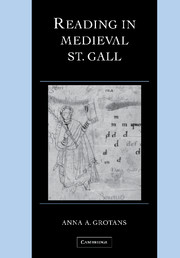Book contents
- Frontmatter
- Dedication
- Contents
- List of plates
- Acknowledgments
- List of abbreviations
- Manuscript punctuation and other symbols
- Introduction
- 1 Medieval reading
- 2 Education at ST. Gall
- 3 Language use and choice
- 4 The ST. Gall Tractate
- 5 Discretio in the classroom
- 6 Accentus
- 7 Spelling for reading
- Bibliography
- Index of manuscripts
- General index
3 - Language use and choice
Published online by Cambridge University Press: 13 May 2010
- Frontmatter
- Dedication
- Contents
- List of plates
- Acknowledgments
- List of abbreviations
- Manuscript punctuation and other symbols
- Introduction
- 1 Medieval reading
- 2 Education at ST. Gall
- 3 Language use and choice
- 4 The ST. Gall Tractate
- 5 Discretio in the classroom
- 6 Accentus
- 7 Spelling for reading
- Bibliography
- Index of manuscripts
- General index
Summary
Teutonus affini sordet, studet ergo Latinis
Extolli soceris seu, quod mage nobile, Grecis.
An important premise for my study of lectio in Notker's St. Gall is that classroom instruction took place in Latin and German, and that texts were read and listened to in both languages. The vernacular was used more than just to gloss the meaning or grammar of individual Latin words. It could be applied to create a continuous written text that served as a complementary vehicle for learning alongside the Latin and facilitated access to it. In positing an enhanced role for the vernacular in the classroom, I do not mean to minimize the importance of learning Latin and of being able to read and understand Latin texts, nor am I suggesting that the vernacular was the main language of instruction. Both languages were used for different purposes at different levels of learning. Although this premise seems reasonable enough, it is nonetheless dangerous to project modern views and pedagogic experience indiscriminately onto a period and culture so far removed from our own. In chapters four through seven of my study, I demonstrate how Notker's bilingual teaching texts are carefully structured to practise classroom lectio in utraque lingua. Before doing so, it is important to review medieval attitudes toward Latin and the vernacular and the relationship between the two in society and in the classroom.
- Type
- Chapter
- Information
- Reading in Medieval St. Gall , pp. 111 - 154Publisher: Cambridge University PressPrint publication year: 2006



